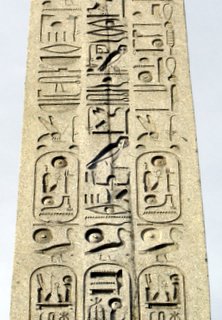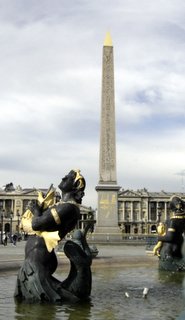Place de la Concorde
Obelisk of Luxor

Metro: Concorde
Arrondissement: 8eme
Go Here For Great Hotel Discounts In This Area
Map of the Area
The Place de la Concorde was designed by architect Jacques Ange Gabriel, in 1755. It is in the shape of an octagon was originally surrounded by a moat.
It stands between the Avenue des Champs-Élysées to the west and theJardin des Tuileries, Garden of the Tuileries, to the east. It contained statues and fountains and was named Place Louis XV to honor the king at the time.
During the French Revolution, the statue of Louis XV was torn down. The square was then renamed "Place de la Révolution". It was on this spot on January 21, 1793, that the new revolutionary government erected a guillotine.
Nearly 1,500 people were executed here. Louis XVI, Marie Antoinette, Robespierre and Danton were among those executed here. They were all beheaded in front of cheering crowds.
There is a bronze plaque placed in the western-center of the Place de la Concorde which commemorates the site of the guillotine and the executions of King Louis XVI, Marie Antionette and the other victims.
At the north end of the Place are two identical stone buildings. Divided by rue Royale, these buildings are among the best examples of that period's architecture. On the east side is the Hôtel de la Marine, the Ministry of the Navy; the Hôtel Crillon is on the west side. Initially, they both served as government offices.
However, the western building was soon converted into the luxurious Hôtel de Crillon. Here, Marie Antoinette spent afternoons relaxing and taking piano lessons.
On February 6, 1778, the Hotel Crillon was the site of the signing of an agreement between the newly formed United States and the French government, with Benjamin Franklin among others representing the U.S. It was a treaty of friendship, commerce and alliance and marked France as the first country to recognize the independence of the United States.
The Hotel Crillon also served as one of the headquarters of the occupying German army during World War II.
On the corners of the Place are large statues representing the greater cities of France.


In the center of the Place de la Concorde stands the oldest artifact as a monument in Paris. The 3,000 year old Obelisk of Luxor was a gift to King Louis-Philippe in 1836 from Muhammed Ali, the Viceroy of Egypt and the Sudan. The Obelisk is inscribed with Egyptian hieroglyphics exalting the reign of the pharaoh Ramses II.
Given the technical limitations of the day, transporting it was no easy feat. On the pedestal are diagrams depicting the machineries used for the transportation and the installation of the Obelisk.
The red granite column rises 23 metres high, including the base, and weighs over 250 tons. Missing its original cap, believed stolen in the 6th century BC, the government of France added a gold-leafed pyramid cap, in 1998.

The beautiful fountains on either side of the Obelisk are said to be inspired from similar ones located near St. Peter's Cathedral in Rome.
To the north of the Place de la Concorde, with a direct view of it via rue Royale, is the church of Ste. Marie Madeleine.
Rue Royale is also where you'll find the famous café Maxim's, at 3 rue Royale. The Art-Deco interior from 1899 is worth a look.
To the south of the Place de la Concorde, across the Seine river by the bridge Pont de la Concorde, is the Assemblée Nationale, the National Assembly.
The Place is also home to the headquarters of the Fédération Internationale de l'Automobile, the rule-making body for Formula One and other world motorsports.

Return to Top of Place de la Concorde and Obelisk of Luxor Page
Private Tours
| Paris Introduction Tour | Paris Islands Tour | Paris Passages Tour |
| Trocodero-Eiffel-Invalides | Marais Tour | Montmartre Tour |
| Latin Quarter Tour | Paris Markets Tour | Paris Churches Tour |
Booking.com
New! Comments
Have your say about what you just read! Leave me a comment in the box below.